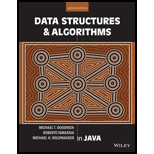
Concept explainers
Explanation of Solution
Implementation of norm(v):
The norm() method takes the input parameter of “vec” to return the Euclidean norm of “vec” array of coordinates.
//Function definition
public static double norm(double[ ] vec)
{
/*Call the norm() by passing the “vec” and “2” and return the result of computed value. */
return norm(vec,2);
}
Explanation:
In norm() method,
- It takes the input parameter of “vec”.
- Call the norm() method by passing the “vec” and “2” and return the result of computed value of p-norm value of “vec” array of coordinates.
Implementation of norm(v, p):
The norm() method takes the input parameter of “vec” and “pow” to return the p-norm value of “vec” array of coordinates.
//Function definition
public static double norm(double[ ] vec, int pow)
{
//Declare the variables
int sum = 0;
double exp = 1.0/pow;
//Loop executes until from “i” to "vec"
for (double i : vec)
//Add the "sum" and the power of number
sum += Math.pow(i,pow);
//Return the return
return Math.pow(sum, exp);
}
Explanation:
In norm() method,
- It takes the input parameter of “vec” and “pow”.
- Loop executes until the “vec” to add the sum and power of input.
- Return the computed p-norm value of “vec” array of coordinates.
Complete Program:
/**********************************************************
* Program demonstrates how to determine the Euclidean norm*
* for two-dimensional
Want to see the full answer?
Check out a sample textbook solution
Chapter 1 Solutions
Data Structures and Algorithms in Java
- For this question you will perform two levels of quicksort on an array containing these numbers: 59 41 61 73 43 57 50 13 96 88 42 77 27 95 32 89 In the first blank, enter the array contents after the top level partition. In the second blank, enter the array contents after one more partition of the left-hand subarray resulting from the first partition. In the third blank, enter the array contents after one more partition of the right-hand subarray resulting from the first partition. Print the numbers with a single space between them. Use the algorithm we covered in class, in which the first element of the subarray is the partition value. Question 1 options: Blank # 1 Blank # 2 Blank # 3arrow_forward1. Transform the E-R diagram into a set of relations. Country_of Agent ID Agent H Holds Is_Reponsible_for Consignment Number $ Value May Contain Consignment Transports Container Destination Ф R Goes Off Container Number Size Vessel Voyage Registry Vessel ID Voyage_ID Tonnagearrow_forwardI want to solve 13.2 using matlab please helparrow_forward
- a) Show a possible trace of the OSPF algorithm for computing the routing table in Router 2 forthis network.b) Show the messages used by RIP to compute routing tables.arrow_forwardusing r language to answer question 4 Question 4: Obtain a 95% standard normal bootstrap confidence interval, a 95% basic bootstrap confidence interval, and a percentile confidence interval for the ρb12 in Question 3.arrow_forwardusing r language to answer question 4. Question 4: Obtain a 95% standard normal bootstrap confidence interval, a 95% basic bootstrap confidence interval, and a percentile confidence interval for the ρb12 in Question 3.arrow_forward
 C++ for Engineers and ScientistsComputer ScienceISBN:9781133187844Author:Bronson, Gary J.Publisher:Course Technology Ptr
C++ for Engineers and ScientistsComputer ScienceISBN:9781133187844Author:Bronson, Gary J.Publisher:Course Technology Ptr Operations Research : Applications and AlgorithmsComputer ScienceISBN:9780534380588Author:Wayne L. WinstonPublisher:Brooks Cole
Operations Research : Applications and AlgorithmsComputer ScienceISBN:9780534380588Author:Wayne L. WinstonPublisher:Brooks Cole C++ Programming: From Problem Analysis to Program...Computer ScienceISBN:9781337102087Author:D. S. MalikPublisher:Cengage Learning
C++ Programming: From Problem Analysis to Program...Computer ScienceISBN:9781337102087Author:D. S. MalikPublisher:Cengage Learning EBK JAVA PROGRAMMINGComputer ScienceISBN:9781337671385Author:FARRELLPublisher:CENGAGE LEARNING - CONSIGNMENTProgramming Logic & Design ComprehensiveComputer ScienceISBN:9781337669405Author:FARRELLPublisher:Cengage
EBK JAVA PROGRAMMINGComputer ScienceISBN:9781337671385Author:FARRELLPublisher:CENGAGE LEARNING - CONSIGNMENTProgramming Logic & Design ComprehensiveComputer ScienceISBN:9781337669405Author:FARRELLPublisher:Cengage Systems ArchitectureComputer ScienceISBN:9781305080195Author:Stephen D. BurdPublisher:Cengage Learning
Systems ArchitectureComputer ScienceISBN:9781305080195Author:Stephen D. BurdPublisher:Cengage Learning





